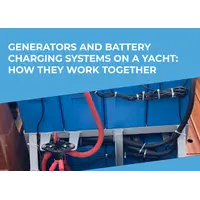topRik experts explain how to care for your charter boat at different times of the year and offer a strategy for regular yacht maintenance, depending on both mileage and season.
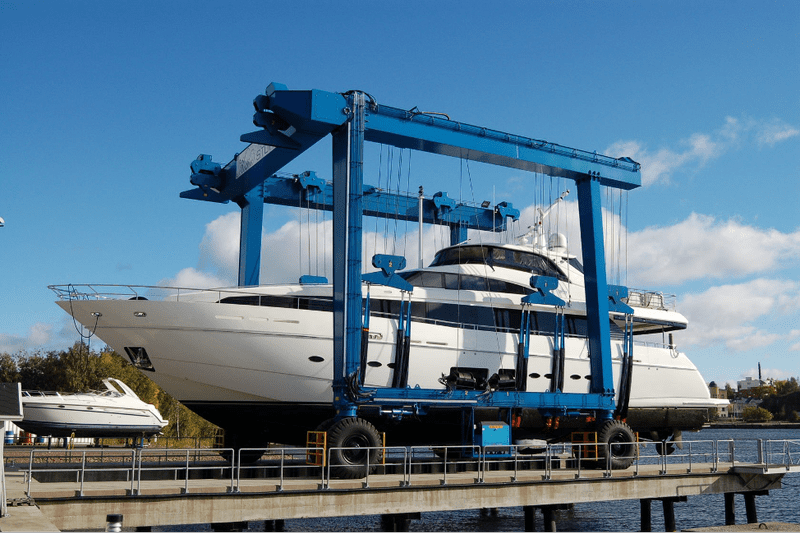
The New Season Begins Right When Past Season Ends
In articles devoted to boat care, we have repeatedly stated that preparation for navigation should begin immediately after the end of the previous season. This ensures that you will not find your yacht in poor condition in the spring. So, immediately after you are done with having fun, you will have to carefully preserve the yacht and organize its winter storage.
Try to avoid mistakes when preserving the yacht, which may subsequently lead to additional waste of money and nerve cells. We hope that the many years of experience of the yachtsmen who service our SimpleSail fleet of dozens of sailing and power boats will help you remember what you have forgotten.
We recommend that novice sailors create their own checklist for boat maintenance throughout the year or use ready-made ones offered by the relevant services of charter companies until all its details are worked out automatically.
And it is advisable for sailors of any level of training and experience, precisely during the mothball period, to immediately draw up a schedule of work on the maintenance, repair and renovation of the vessel in the fall, during the winter lay-up of the boat, as well as in the spring, before the opening of the next season.
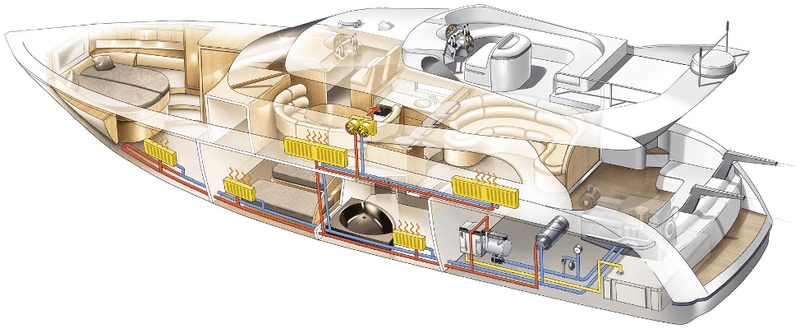
As a rule, the season ends in late autumn, and no matter what warm region you are in, winter temperatures can negatively affect the condition of the yacht if it is left to spend the winter in the water. Also keep in mind that modern small boats are a set of all kinds of complex systems (mechanical, electronic, electrical, hydraulic, etc.) that are not designed for temperature fluctuations, much less subzero temperatures.
But even if you store the yacht in a warm boathouse, conservation is necessary. So lifting a boat onto land or placing it in a boathouse is just the beginning of preparing it for the next season.
The main attention in the process of preserving a yacht should be paid to electrics, drives and mechanical systems, as you do when maintaining a yacht by engine hours.
topRik team sailors shows that boat engines are very reliable and long-lived devices that can outlive the life of the boats themselves. But only if they are provided with careful care.
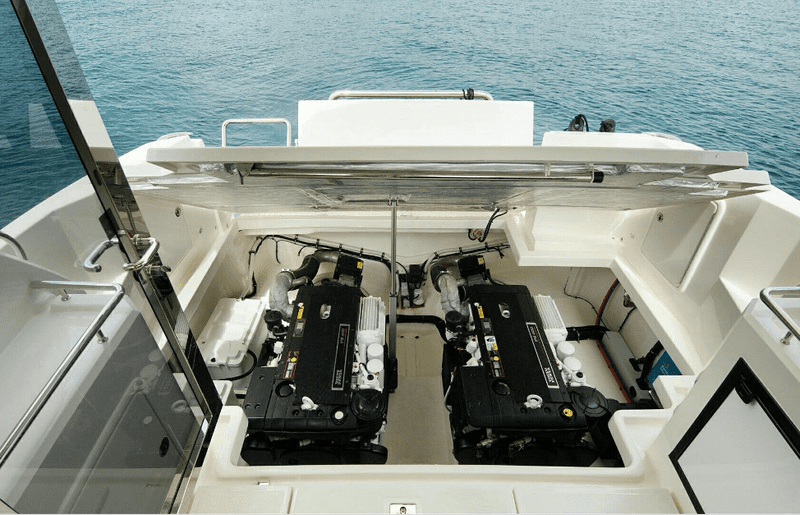
Therefore, at the end of the season, we replace all filters, other consumables, as well as oils and all operating fluids. We don't even skip two-stroke outboard motors, which seem to require little maintenance. But it should be borne in mind that during the season, even into their gearbox with oil, water can seep through the oil seal.
The bearing is guaranteed to rust in winter; frost can rupture the silumin housing or squeeze out the seal. The larger the boat, the more different mechanisms and systems it has: latrines, showers, air conditioners, jacuzzi, crane beams, bathing platform, etc. Many of them contain various technical fluids that can freeze, so all these systems should be maintained in the process of preserving the yacht for the winter.
For example, the water supply system of a boat should be preserved with products that contain propylene glycol or ethylene glycol with the addition of alcohol and dye, which are safe for the human body. The presence of dye during subsequent tank flushing in the spring will help control the complete removal of all preservative liquid. We do not recommend using toxic compounds such as antifreeze for preservation, even when preparing a process water system, not to mention drinking water.
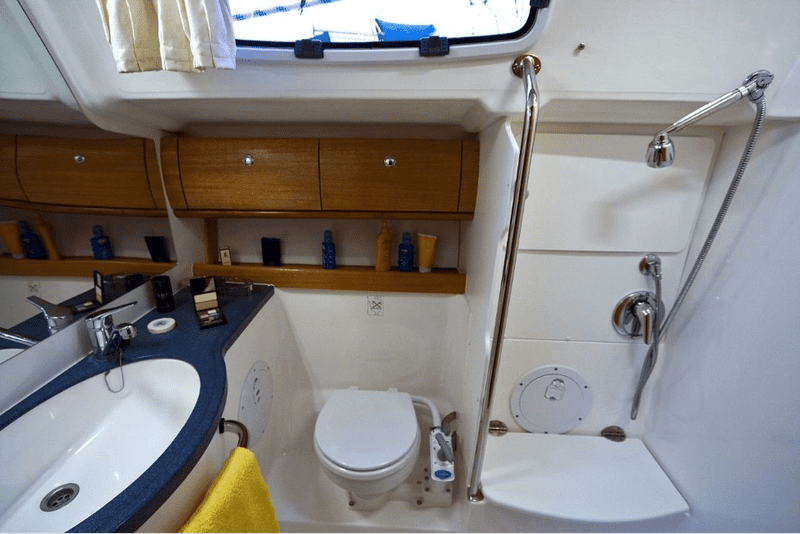
We warn against the desire to save on everything, especially when it comes to preparing fuel tanks for wintering. Under no circumstances should you leave them half-empty for the winter - the condensation that forms over the winter will subsequently result in clogged filters. We understand that there may be nowhere to store drained fuel, as well as the reluctance of yachtsmen to spend money on additional fuel at the end of the season. But later, such “savings” can turn into trouble. Moreover, at the beginning of navigation you will still have to fill up with fuel, and there is no guarantee that by then prices will not rise.
By the way, we are supporters of winter storage of a yacht with full tanks, since condensation can form even in empty ones. And if the tanks are not full, even special additives will not stop the formation of condensation.
Although screws and shafts as parts of systems do not require maintenance, their geometry should be checked if vibration is present. The geometry can be disrupted when running aground or colliding with a drifter. Continued operation of the yacht with such violations will lead to gearbox failure. So, if there is vibration on the yacht in the last days of the season, checking the geometry of the shafts and propellers falls into the category of urgent work.
If you have one charter yacht and you service it yourself, then in the spring you will know exactly what condition it is in so that you can properly service it before the new season. But if you have several yachts, or you are not at all interested in maintaining the boats yourself, then our advice is: invite the same master mechanic or the same team that prepared the yachts for wintering for their spring preparation also.
We remind you once again: do not rely on your memory - keep a journal or form for each boat (or even the only one), where you note all the parameters, the condition of mechanisms and systems, the results of technical inspections, repair work, sea trials at the end and before the start of the season, etc.
During the testing process, before lifting the boat, it is advisable to check the operation of all systems and equipment, including the generator, desalination and air conditioning, so that in the spring the charter boat owner knows what tasks to assign to the mechanic or service company.
Winter Storage
Winterizing a boat with a metal hull usually does not cause problems: hulls made of steel or alloys can even winter in water or ice. But yachts with fiberglass hulls require dry and warm storage for successful winter storage.

But do not think that the presence of such a room - an equipped boathouse or garage, a barn - frees you from the process of preserving the yacht. After all, problems with electricity can arise regardless of the preparedness of the room for winter storage of the boat.
In addition, most owners and charter companies, especially those located in warm regions, prefer to winterize boats on the shore, under awnings, since maintaining their own boathouse or renting it is expensive.
If you intend to use a heater to maintain a positive temperature in the boat, remember that in this case regular ventilation is necessary. Otherwise, you risk severely damaging the furniture and other wooden parts of the yacht’s interior by the opening of the season, by overdrying them and disturbing the natural humidity.
To create a normal temperature regime, you can use shrink film or an awning, which is capable of maintaining a temperature of about +10 °C in all spaces of the vessel.
Many yacht owners do this: they cover the yacht with an awning and don’t think about it until spring. Of course, if the temperature regime of the region allows such storage, this is quite acceptable: yachts with a fiberglass hull can be used for 5-7 years without any special consequences, and if the finishing does not contain expensive and sensitive materials, then even longer.
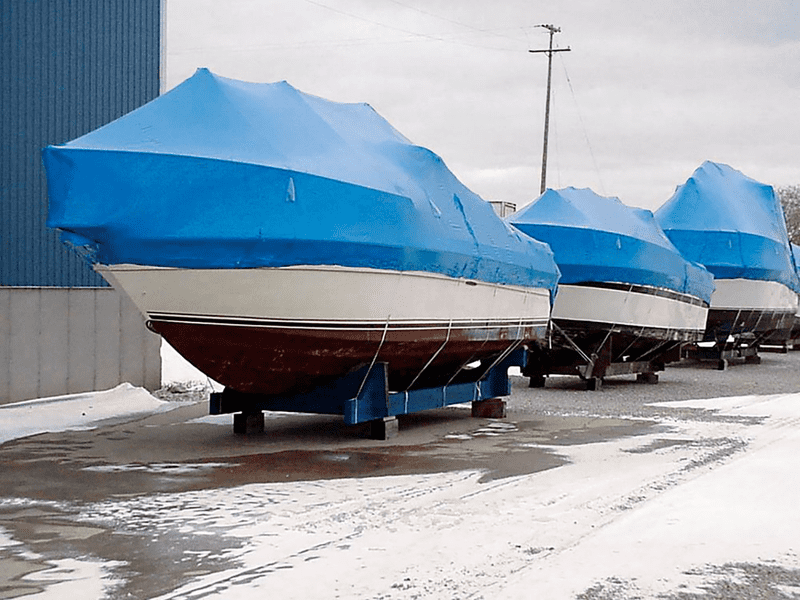
But if there is at least some risk of sudden temperature changes in the storage region, you should consider renting a boathouse. Because it is these changes (and not stable low temperatures) that pose a particular danger to a fiberglass boat.
If you are the happy owner of a warm boathouse or garage for storing a yacht, then a significant part of the work on board can be carried out in winter. But when stored under an awning, this list is very limited, unless you can install additional navigation, audio and video equipment, satellite systems, antennas, etc.
During wintering outside, you can also prepare holes for equipment, which you can install using sealant when it gets warmer.
Polishing, sanding the hull, applying antifouling to the bottom, laying teak decking can only be carried out at a temperature not lower than +15 °C.
It is necessary to know such things in order to correctly distribute work from season to season. After all, if you do not take the opportunity to complete some of the work in the winter, with the opening of the navigation season in the spring you will have to deal with it in a rushed situation, since during this period not even every day is important, but every hour, especially if you have several charter boats, and impatient tenants are already ready to go to sea.
Open Season
If all of the above is given due attention: the boat is properly preserved in the fall and stored in the winter in acceptable condition, then before launching all that remains is to check and adjust all the systems, remove the preservative, launch the boat and make a test run.
Our fleet service SimpleSail has developed special checklists for all types and even models of yachts to prepare the yacht for navigation. They include up to 100 positions that provide for inspection of the boat before launching. This does not mean that the boat will be on the water only after a full check, because many systems are subject to diagnostics only on the move (for example, checking the generator, checking the stability of engines when changing modes, detecting vibration, etc.) Therefore, when the right weather conditions arrive for the launch, we conduct sea trials and eliminate possible faults.
If you have from one to three boats, this is easier for you to do, so just make this order a rule.
But there are also items that can only be checked on land: the drive (shaft, shaft support, propeller, corner column, water jet), anodes, the condition of the antifouling coating and its renewal, if you did not do this in the fall. The condition of the fiberglass must be assessed to ensure there are no cracks that provoke the development of osmosis.
When preparing a boat for navigation, electronic maps are often updated, navigation and TV equipment are adjusted, especially if a change of water area is planned in the coming season. Often before the start of the season, boat owners want to freshen up the interior: reupholster wall panels, change vinyl (especially on the flybridge), clean or update the teak flooring. If the boat is stored “outdoors”, this work is really best left for the spring, since a harsh winter can ruin your efforts and investments.
And the last aspect of preparing a boat for the season, although not technical at all, is insurance, which you should not skimp on. Even launching a yacht by crane, not to mention the entire season, can be fraught with unpleasant surprises. In addition, even in a protected area, at a parking lot in a marina or harbor, insured events are possible. You really don’t want to be left without insurance payment if something like this happens.



